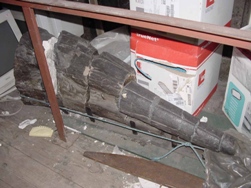
The Bristol posterior skull
This skull (Bristol City Museum, now registered Cc 940) was listed, by its imaginative auctioneer, fellow fossil collector Thomas Austin Jr. (1817-?), who later emigrated to Canada, as Lot 360.
“Extraordinary large head of icthyosaurus [sic] platyodon, from Lyme, Dorsetshire. This unique specimen shews the gigantic dimensions the reptilian race attained to the earlier ages of our planet; we also learn from the large size of the creature's eyes which are upwards of 12 inches in their longest diameter, that the waters of the liasic [sic] seas were rendered turbid by those irruptions of matter, inimical to saurian life, which have so frequently enveloped and preserved in the highest perfection their prostrate remains”
4.
A drawing of this enormous skull survives, in the collection of Richard Owen drawings at the Natural History Museum in London. It is numbered 117b and annotated by William Clift (1775-1840), curator at the Royal College of Surgeons:
“No. 3 Enormous head of a (supposed) Gavial Aligator [sic] discovered in 1813 near Low Water Mark at L[yme] in Dorsetshire, and now in the possession of Mr Johnson of Bristol. Designed by G[eorge] C[umberland] from the Original fossil. February 1814"
Clift also notes its dimensions as "2' 6" broad, 2‘ 10" long and 11" thick". The enormous eye sockets are recorded as "14 1/2 " long by 7" wide", with some of the sclerotic plates preserved. Ingles & Sawyer
5 list this drawing as an "incomplete skull with matrix, dorsal [view], 1 water colour drawing by George Cumberland [1754-1848 of Bristol], annotated". A copy of this drawing was also sent to Georges Cuvier in Paris, which also survives
6.
Cumberland later recorded of this specimen that: "Mr James Johnson of Bristol, in 1813, raised an enormous head from low-water mark at Lyme and brought it to Bristol at the expense of twenty pounds; it weighed, I believe near a ton...
7. We know, from a letter dated 28 November 1813, that Johnson "had [then] lately purchased it... he gave 10 guineas for it and 2 guineas for the carriage from Lime or Charmouth where it was found. It is a stupendous thing"
8. Thomas Hawkins
9 later confirmed "it has been the appui [support] for many a tale, on account of its large eye sockets. It possesses no specifical identification whatever".
The survival of this drawing enabled Peter Crowther and me to prove, after such a specimen was re-discovered in Bristol Museum's L Shed in 1987, that this Johnson specimen had miraculously survived in Bristol City Museum collections. Here it was displayed in their “Great Sea-Dragons” exhibition in 1989
10 and is now registered Cc 940. It had been purchased by James Naish Sanders (1776-1870)
11 for the Bristol Institution, at the Johnson sale, for £27 & 10 shillings, where "there had been warm competition for its possession, and Sanders out bid the British Museum"
12. In its 3’ x 2’ 6” wooden frame, it was photographed, on display in the late 1930s, below the now-lost type specimen of
Plesiosaurus megacephalus Stutchbury 1846 (photo in Bristol Museum archives), but must have been put in store before the Museum was fire-bombed late in 1940, and forgotten.